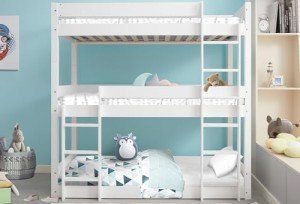The Ultimate Guide to Bunk Beds for Children: Safety, Styles, and Benefits
When it comes to styling a kid's space, moms and dads typically deal with the dual obstacle of taking full advantage of space while ensuring comfort and functionality. Bunk beds have actually become a popular solution that addresses these needs, offering not simply sleeping arrangements but also contributing to a room's visual. In Bunk Beds Store detailed guide, we will look into various elements of children's bunk beds, focusing on their advantages, safety functions, styles, and considerations for moms and dads considering this purchase.
Tabulation
- Advantages of Bunk Beds
- Security Features to Consider
- Kinds Of Bunk Beds
- Style and Style Options
- Upkeep Tips
- Regularly Asked Questions (FAQs)
1. Benefits of Bunk Beds
Bunk beds provide various advantages for children and their moms and dads. Here are some essential advantages:
- Space-Efficiency: Bunk beds are an excellent solution for smaller sized rooms. By stacking one bed on top of another, more floor space is offered for play, storage, or study areas.
- Cost-efficient: When children share spaces, bunk beds can lower the need for purchasing 2 different beds, hence saving cash.
- Promotes Social Interaction: Bunk beds can assist brother or sisters or pals bond by sharing a space, creating chances for social advancement.
- Enjoyable Factor: The principle of sleeping "up high" includes a playful aspect to bedtime, making the shift to sleeping alone simpler for some children.
- Versatile Design: Bunk beds can be found in numerous designs, colors, and develops to match any room style, allowing for customization that reflects the kid's character.
2. Safety Features to Consider
Safety is critical when it pertains to children's furniture, particularly when it comes to bunk beds. Here are some critical safety features to assess:
| Safety Feature | Description |
|---|---|
| Strong Construction | Frames made of solid wood or metal are chosen. |
| Guardrails | Should be at least 5 inches high and extend along both sides of the upper bunk. |
| Ladder Design | Guarantee ladders are securely attached and have non-slip steps. |
| Mattress Size & & Fit | Should fit comfortably within the frame to prevent spaces. |
| Weight Limit | Constantly stick to the producer's weight limit recommendations. |
3. Types of Bunk Beds
Bunk beds come in several styles, dealing with numerous requirements, choices, and space sizes. Here are some common types:
- Standard Bunk Bed: The the majority of fundamental type, with one bed on top of another.
- Loft Bed: Features a high upper bed with space below for a desk or play location.
- Futon Bunk Bed: Combines a leading bunk with a futon on the bottom, offering flexibility for seating and sleeping.
- L-Shaped Bunk Bed: This design has the leading bunk set at a perpendicular angle to the bottom, producing a small corner location.
- Triple Bunk Bed: Accommodates three kids utilizing stacked beds, suitable for big families or pajama parties.
4. Style and Style Options
When it comes to picking a design for children's bunk beds, the options are practically unlimited. Here are some popular styles:
- Traditional Style: Often made of wood, these bunk beds feature ornate details and are perfect for classic or rustic-themed spaces.
- Modern Style: Characterized by clean lines and minimalist styles, contemporary bunk beds can be made from metal or wood.
- Themed Bunk Beds: Some brand names use bunk beds formed like castles, cars, or playhouses, making bedtime less of a task.
- Convertible Bunk Beds: These can be separated into two individual beds, offering versatility as kids grow.
- Colorful Options: Bunk beds in lively colors can add a sense of delight and playfulness to any space.
5. Maintenance Tips
Keeping a bunk bed is vital for durability and safety. Here are some ideas:
- Regular Inspections: Check for loose screws or bolts every few months and tighten them as required.
- Cleaning: Wipe down frames regularly to avoid dust build-up; consider using a vacuum for hard-to-reach areas.
- Bed mattress Care: Rotate mattresses regularly and utilize protective covers to extend their life.
- Expect Wear and Tear: Look for any signs of damage in the wood or metal and consider changing parts if needed.
- Teach Kids Safety Rules: Encourage children to utilize ladders correctly and guarantee they understand the security features of their bed.
6. Often Asked Questions (FAQs)
Q1: What age is proper for oversleeping a leading bunk?
A1: Typically, kids aged 6 and older are advised for upper bunk sleeping, as they have the necessary motor abilities to climb securely.
Q2: Do bunk beds feature a bed mattress?
A2: Most bunk beds are offered as frames only, so you will need to buy mattresses individually. Guarantee that the bed mattress fits the frame comfortably.
Q3: Can bunk beds be separated later on?
A3: Many styles enable conversion into 2 private beds, providing versatility for future needs.
Q4: How can I ensure my child's safety on a bunk bed?
A4: Comply with security standards and guarantee guardrails, a tough frame, and a secured ladder are in location.
Q5: Are there weight limitations on bunk beds?
A5: Yes, always inspect the maker's specifications concerning weight limits to guarantee safety.
Bunk beds for kids can serve several functions while guaranteeing safety and style. With varied styles and models offered on the market, parents can find a system that not only maximizes bed room space but also shows their child's unique tastes. Just like any furniture, comprehending safety functions, upkeep, and how they suit a kid's lifestyle will guarantee that these beds remain a practical furnishings service for years to come.
Through careful factor to consider and adherence to security standards, bunk beds can provide a long-lasting, enjoyable, and functional sleeping solution that kids enjoy.

